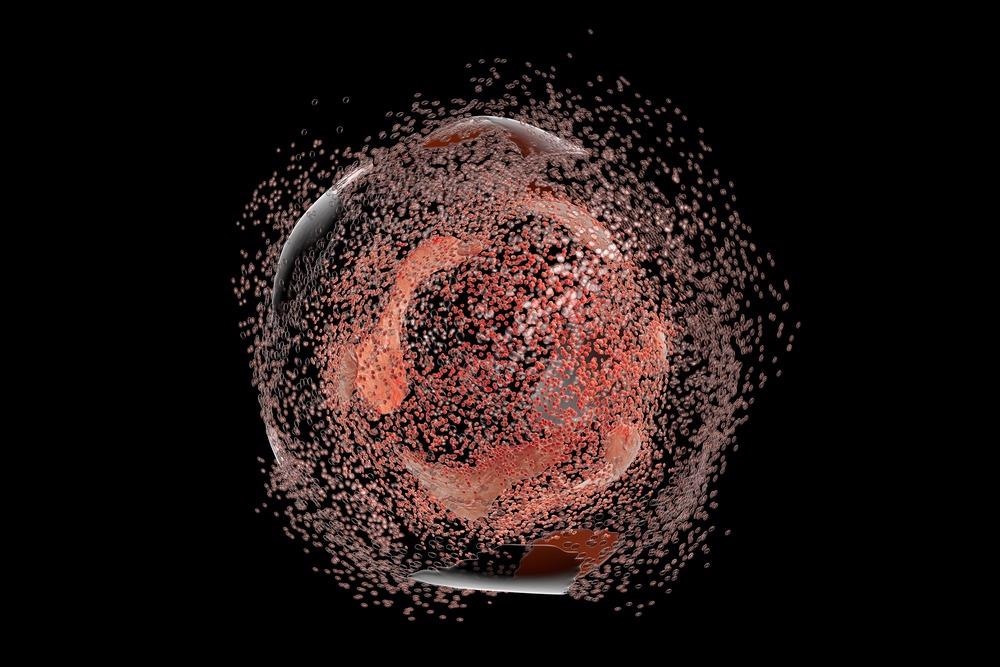Drug resistance is a common phenomenon, with drugs becoming less and less effective as their usage increases. To address this issue, a novel technique employing conjugated polymer-based nanoparticles is presented in the study published in the journal ACS Applied Materials and Interfaces.

Study: Polymer Nanoparticles Overcome Drug Resistance by a Dual-Targeting Apoptotic Signaling Pathway in Breast Cancer. Image Credit: Kateryna Kon/Shutterstock.com
What is TRAIL?
TNF-related apoptosis-inducing ligand (TRAIL), a part of the TNF superfamily, preferentially promotes cancer cell apoptosis (programmed death) by binding itself to death-associated receptors. As a result, it is regarded as a prospective cancer treatment agent.
TRAIL connects to the death receptors, bringing together caspase-8 and Fas protein-associated death domain (FADD) to create a death-inducing signaling complex (DISC), that triggers the apoptosis mechanism. Yet, resistance to TRAIL significantly reduces the therapeutic effectiveness of TRAIL cancer treatment.
Research Into Apoptosis
Recent studies have demonstrated that calmodulin attaches to DISC to regulate apoptotic impulses, and the mixture of calmodulin antagonists and TRAIL reduces TRAIL-associated breast cancer therapy resistance. Nevertheless, TRAIL protein translation is hampered by weak pharmacokinetic characteristics.
Synergistic calmodulin antagonists combined with TRAIL genetic therapy are considered a potential way to circumvent these restrictions. To increase the effectiveness of TRAIL treatment, it is critical to build a hybrid delivery system that accurately controls the expression of genes and the release of drugs.
To construct such a hybrid delivery system, near-infrared light-based remote and control of cell’s physiological functions has received plenty of interest.
What makes Near-Infrared Light Ideal?
The largest advantage that near-infrared light has is that it may penetrate further into tissues while causing very little damage to the cell. Furthermore, by employing near-infrared absorbing substances, near-infrared light may be transformed into thermal energy or other forms of energy.
Many near infrared-absorbing nanomaterials, such as nanostructures, Prussian blue nano-cubes, up-converting nanoparticles, conjugated polymer-based nanoparticles, and 2D nanomaterials have lately been produced.
Owing to their superior tissue penetrating capabilities and biological compatibility, conjugated polymer-based nanoparticles have been extensively utilized in light-based thermal therapy, bioimaging, and cellular function modulation.
Could Conjugated Polymer-Based Nanoparticles be the Key?
The team demonstrated an approach for gaining control of the tumor PI3K/Akt signaling pathway for increasing cancerous cell apoptosis by using conjugated polymer-based nanoparticles tagged with calmodulin antibody and near-infrared irradiation.
The conjugated polymer-based nanoparticles converted light into thermal energy when subjected to near-infrared light, which triggered the HSP70 promoter.
The triggering of the HSP-70 promotor resulted in the initiation of downstream EGFP gene production in live cells. However, it was deduced that combining light-based thermally regulated genetic expression with disease-associated signaling pathways is more clinically meaningful.
According to the team's understanding, no research group has documented a technique for reducing breast tumor development through light-based thermal stimulation of TRAIL gene expression with the help of conjugated polymer-based nanoparticles.
In the current research, the team devised a novel technique to eliminate pharmacokinetic inadequacy and TRAIL resistance, Using near infrared-absorbing conjugated polymer-based nanoparticles.
Key Findings of the Study
The team effectively designed near-infrared light-absorbing conjugated polymer-based nanoparticles with dual functionalities to regulate and selectively trigger TRAIL-regulated apoptotic signaling.
The conjugated polymer-based nanoparticles demonstrated significant near-infrared light-based thermal conversion capacity as well as good biological compatibility. The lipid coatings utilized for the conjugated polymer-based nanoparticles were DPPC and DSPE-PEG-PEI, which were subsequently electrostatically linked to therapeutic p-DNA.
The team noted that the transition temperature associated with DPPC and the responsive temperature associated with the HSP-70 promoter in the conjugated polymer-based nanoparticles were both 41°C. This similarity in temperatures allowed conjugated polymer-based nanoparticles to regulate drug release and gene expression concurrently under near-infrared light irradiation.
The conjugated polymer-based nanoparticles converted light into thermal energy and raised the temperature significantly, subsequently triggering an HSP-70 promoter to commence the expression and transcription of TRAIL genes. This resulted in the TRAIL-regulated apoptotic signaling being activated.
Concurrently, the conjugated polymer-based nanoparticles produced W-7, which facilitated the fragmentation of TRAIL-associated caspase-8 and increased cancer cell apoptosis.
The team concluded that conjugated polymer-based nanoparticles/W-7/p-TRAIL might accumulate at tumor locations in vivo and have outstanding anticancer effectiveness and biosafety. As a result, the study offered a viable therapeutic and diagnostic method for remote modulation of TRAIL-regulated apoptotic signaling to increase TRAIL-resistant cancerous cell apoptosis.
Reference
Li, N., Gao, D. et al. (2022). Polymer Nanoparticles Overcome Drug Resistance by a Dual- Targeting Apoptotic Signaling Pathway in Breast Cancer. ACS Applied Materials & Interfaces. Available at: https://pubs.acs.org/doi/10.1021/acsami.1c23146
Disclaimer: The views expressed here are those of the author expressed in their private capacity and do not necessarily represent the views of AZoM.com Limited T/A AZoNetwork the owner and operator of this website. This disclaimer forms part of the Terms and conditions of use of this website.